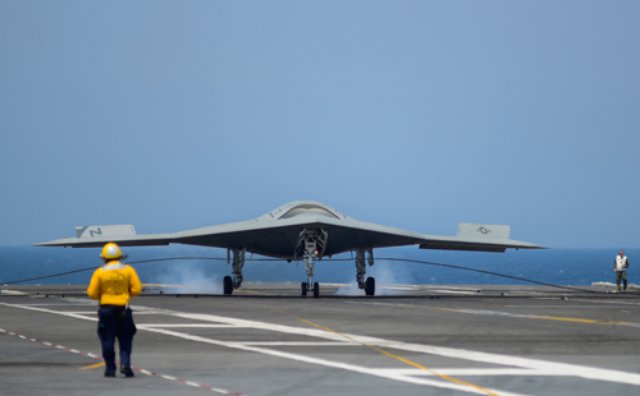 A malfunction during the Navy’s high-profile test flight of its X-47B Unmanned Combat Air System showed that the aircraft can operate in adverse conditions, service officials said.
A malfunction during the Navy’s high-profile test flight of its X-47B Unmanned Combat Air System showed that the aircraft can operate in adverse conditions, service officials said.
The tailless, airborne autonomous aircraft landed on the naval aircraft carrier USS George H.W. Bush for the first time July 10, paving the way for future use of unmanned aircraft systems in carrier operations.
“It was nothing short of amazing,” Rear Admiral Mat Winter, programme executive officer for unmanned aviation and strike weapons, said during a July 11 conference call.
Despite its success, concerns were raised regarding the last of three landing approaches. In it, the aircraft diagnosed a malfunction within its navigation system that caused it to divert its course to Wallops Flight Facility in Virginia.
This incident proved to naval officials that the X-47B was able to function autonomously.
“You have to design it with unprecedented levels of reliability and system safety,” said Capt. Jaime Engdahl, Navy UCAS programme manager. “Everything went right.”
In this case, one of the three navigational sub-systems failed, according to post-flight data. “The other two [subsystems] realized that. It exercised its already pre-planned logic and identified that sub-system anomaly, provided that indication to the mission operator who then made the appropriate choice to follow the procedures in the test plan,” said Engdahl.
From the perspective of its managers, the system was designed for scenarios including off-nominal behaviour, he added.
“On every test, we have some type of anomalous behavior,” Winter added.
Both officials agreed that they are looking for consistency in upcoming tests.
The Northrop Grumman-built aircraft flew for the first time less than a year ago at Naval Air Station Patuxent River.
Although there was potential for technical difficulties associated with such a project, the aircraft has seen many successes. “What stuck with me was the ease with which everything happened,” Engdahl added.
The aircraft has laid claim to several achievements. On May 14, it became the first unmanned aircraft to be catapult launched from a carrier. Just three days later, it performed touch-and-go landings on the Bush.
Although this is the final phase of the demonstrator programme, it was the first of three scheduled tests with the second scheduled for July 15.
As for the future of the programme: “We’re not in a rush to do anything. Everything is methodical,” said Winter. At this point, there are no further objectives that are critical for the programme, said Engdahl.
Source: National Defense
